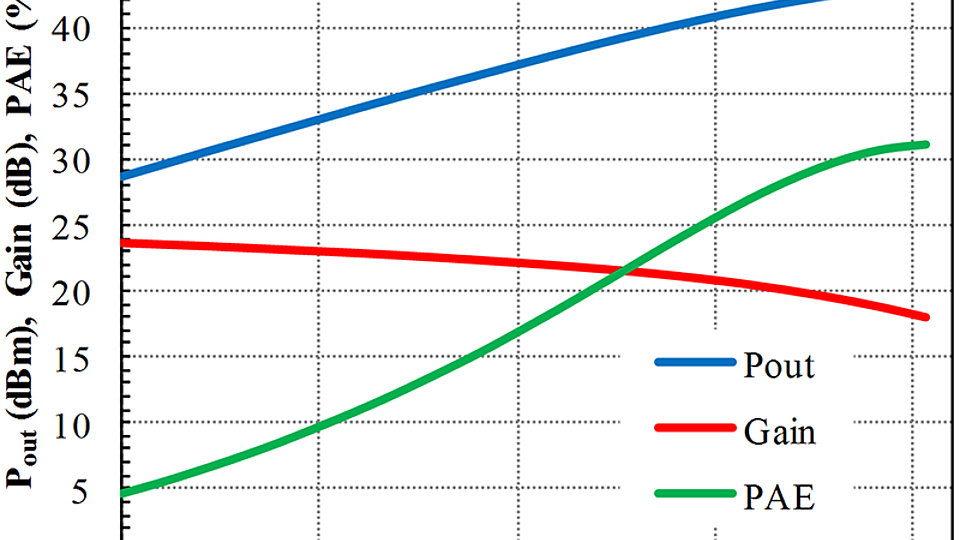Balanced 20 W GaN X-band power amplifier
Power amplifiers (PA) are key components of any communication, radar or satellite system. Being the last element in the transmitter chain before the antenna, they dominate the overall properties. The most important figures of merit are output power Pmax and power-added efficiency PAE. The PAE indicates how much of the consumed power is actually available for the application and how much is dissipated into (thermal) losses. High efficiency is a key issue in view of environment (CO2 emission) as well as system performance.
The combination of high power, high efficiency, and high operating frequency is a problem for most common semiconductor technologies, which is due to physical constraints. In this regard, gallium nitride (GaN) outperforms most of its competitors as it offers both high breakdown electric fields and high electron mobility. This makes it the ideal choice for microwave power amplifiers. It allows to realize PAs with previously unattainable values for output power and PAE.
Various radar and satellite systems operate in the X-band, the frequency range from 8 to 12 GHz. In this frequency range, amplifiers are commonly built as monolithic circuits (MMICs, Monolithic Microwave Integrated Circuits), because through the monolithic realization critical tolerances and parasitic properties can be reduced. At FBH, a GaN MMIC process with 0.25 µm gate length is available which also serves this purpose. Its transistors achieve efficiencies of 50% and more at 10 GHz in deep-AB operation.
Fig. 1 presents a recently designed and realized power amplifier MMIC using this process. Since the GaN semiconductor layers are grown on silicon carbide (SiC), the substrate is transparent and the metal structure of the circuit in Fig. 1 seems to float. In order to achieve high gain, a two-stage design is employed. Different from most other X-band PA MMICs, the circuit is realized in coplanar technology, i.e., with all conductors on the top side of the chip. The MMIC delivers a maximum output power Pmax of 12 W at 10 GHz. A maximum linear gain of approximately 26 dB is obtained, the efficiency of the final stage (Drain Efficiency, ƞDrain,FS) reaches almost 45% and the overall efficiency 35%. These values were achieved through in-depth circuit optimization.
With this amplifier MMIC as basic building block a balanced amplifier was designed and fabricated as a hybrid circuit. The balanced amplifier approach makes it possible to increase the output power by merging the signals of two amplifier modules, while only slightly degrading efficiency and gain compared with the individual amplifiers. The combining of the individual amplifier MMICs is realized by means of hybrid couplers. Fig. 2 shows the balanced amplifier with branchline coupler implementation. Input and output impedances of this hybrid amplifier circuit are 50 Ω.
As can be seen from the measurement curves in Fig. 3, the module delivers a maximum output power Pmax of 21.9 W at 10 GHz. The values for linear gain of 24 dB and overall efficiency (PAE) of almost 31% are only slightly lower than the respective values of the MMICs.
The circuit is mounted on a copper heatsink, together with coaxial connectors at input and output. The module can be used for various applications. At FBH it is used, for example, as drive amplifier in a load-pull measurement set-up.
Publications:
E. Ersoy, O. Bengtsson, W. Heinrich, “Enhancing Dynamic Range and Accuracy of Load-Pull Measurements by Using Prematched Transistors”, 9th German Microwave Conference (GeMiC 2015), Nuremberg, Germany, Mar. 16-18, ISBN 978-3-9812668-6-3, pp. 307-310 (2015).
E. Ersoy, S. Chevtchenko, P. Kurpas, W. Heinrich, "Potential of Coplanar X-band GaN-MMIC Power Amplifiers", Frequenz, vol. 68, no. 9-10, pp. 415-419 (2014).
Thai Nguyen-Xuan, “Balancierter GaN-X-Band Leistungsverstärker”, master thesis written at Technische Universität Berlin and Ferdinand-Braun-Institut, Leibniz-Institut fuer Hoechstfrequenztechnik, on July 2014.


